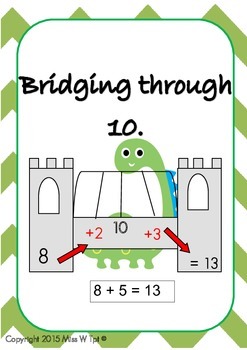Bridging To 10
Bridging to 10 is a fundamental concept in elementary math, and it is one of the building blocks towards understanding more complex mathematical concepts. Whether you are a parent, teacher, or student, understanding bridging to 10 is crucial in developing strong mathematical skills that will last a lifetime. In this blog post, we will explore the concept of bridging to 10 and discuss its importance in the world of mathematics.
Pain Points related to Bridging to 10
Many students struggle to understand the concept of bridging to 10. This is often due to a lack of foundational knowledge in basic addition and subtraction, or difficulty understanding number bonds. Additionally, it can be challenging for students to visualize the concept of bridging to 10, making it harder to grasp the concept and apply it to other mathematical concepts.
The Target of Bridging to 10
The target of bridging to 10 is to make it easier for students to perform mental math and solve more complex equations. It is a core concept in elementary math that builds on basic addition and subtraction skills. By understanding bridging to 10, students can quickly and accurately solve problems such as 7 + 6 or 9 + 8 by first bridging to 10 and then adding the remaining numbers.
Summary of Main Points
In summary, bridging to 10 is a crucial concept in elementary math that lays the foundation for understanding more complex mathematical concepts. Students who struggle with bridging to 10 often struggle with more complex equations in the future, making it essential to master this concept early on. By bridging to 10, students can perform mental math more efficiently and handle more complex problems with ease.
Personal Experience with Bridging to 10
As a former elementary teacher, I have seen firsthand the importance of bridging to 10. I have had students who struggled with basic addition and subtraction concepts, making it challenging for them to master more complex mathematical concepts. However, by introducing them to the concept of bridging to 10, they were able to grasp the concept more quickly and apply it to other mathematical scenarios.
The idea of bridging to 10 is to take one number and break it down into smaller pieces that equal 10. For example, if you have the equation 7 + 6, you can first bridge 6 to 10 by adding 3 to 6 to get 9. From there, you can add the remaining one to get an answer of 13. This mental math technique can be a game-changer for students struggling with more complex problems, and it makes math more manageable and enjoyable.
How to Teach Bridging to 10
The best way to teach bridging to 10 is through hands-on activities and games. Worksheets and drills can be helpful, but they do not always engage students and can be tedious. Instead, consider using manipulatives such as blocks or counting bears to help students visualize the concept. Play games such as "Bridging Bingo," where students must bridge numbers on the board before covering them with a chip. Make it fun and engaging, and your students will be more likely to retain the concept.

Common Misconceptions about Bridging to 10
One of the most common misconceptions about bridging to 10 is that it is only useful for basic addition and subtraction problems. However, this concept is applicable to more complex mathematical equations and provides a foundation for understanding more challenging topics such as multiplication and division. Additionally, some students may struggle with the concept because they do not have a strong grasp of number bonds.
Question and Answer Section
Q: What is the difference between bridging to 10 and making ten?
A: Bridging to 10 involves breaking one number down into smaller pieces that equal 10. Making 10 involves combining two numbers to equal 10, such as 3 + 7 or 4 + 6.
Q: How can I help my child understand bridging to 10?
A: Use hands-on activities and games to help your child visualize the concept. Make it fun and engaging, and provide plenty of opportunities for practice.
Q: Is bridging to 10 essential for more advanced mathematical concepts?
A: Yes, bridging to 10 is a foundational concept that builds on basic addition and subtraction. It provides a foundation for more advanced mathematical concepts such as multiplication and division.
Q: What are some common misconceptions about bridging to 10?
A: One common misconception is that it is only useful for basic addition and subtraction problems. Additionally, some students may struggle with the concept because they do not have a strong grasp of number bonds.
Conclusion of Bridging to 10
Bridging to 10 is a crucial concept in elementary math that provides a foundation for more advanced mathematical concepts. By breaking one number down into smaller pieces that equal 10, students can perform mental math more efficiently and solve more complex problems with ease. Use hands-on activities and games to help students grasp the concept, and address any misconceptions early on to ensure a strong foundation for future mathematical success.
Gallery
Bridging To 10 - Addition - YouTube

Photo Credit by: bing.com / bridging addition
This Engaging IWB Lesson Will Help Your Students To Understand The

Photo Credit by: bing.com / bridging strategy ten decades bridge adding students choose board iwb engaging understand lesson help
Adding To Bridge 10 | Teaching Resources

Photo Credit by: bing.com /
Bridging - YouTube
Photo Credit by: bing.com / bridging
Bridging Through 10 Addition By Miss W TpT | Teachers Pay Teachers

Photo Credit by: bing.com / bridging through addition strategy bonds teaching ten maths bridge math year grade number activities teacherspayteachers ks1 using visit choose board
